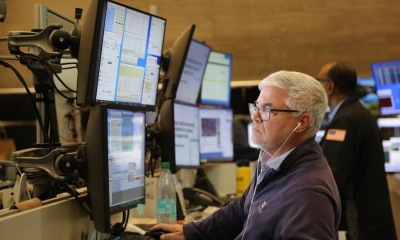Trump-Xi Summit Helps Put U.S.-China Relationship Back on Track

Expanding cooperation with China could provide a more rapid development of U.S. capabilities than attempting to produce a domestic equivalent of Chinese products that have already been on the market.
It was with great expectations that the world awaited the much-needed summit between the leaders of the world’s two most important nations, the U.S. and China. The somewhat rough-edged – and arbitrary – nature of President Trump’s tariff policy, and the threat of tariffs to foster negotiations on trade, has created a great deal of consternation and uncertainty among the trading partners of the U.S., in particular, the People’s Republic of China. During his recent Asian tour, however, Trump has shown a preference for making “deals” rather than issuing threats. This was also his preferred method in dealing with China.
The summit was, however, preceded by extensive negotiations between the two sides, and it had become clear that the U.S. had the opportunity to make a deal with China that was acceptable to, even necessary for, the Trump administration. The threat of 100 percent tariffs on Chinese goods was withdrawn, and the meeting exuded an aura of conciliation, even a degree of friendship. Observers noted, however, that this may be more of a “truce” than a “peace agreement,” given the differences in which the two leaders see the world that is emerging.
Fundamentally, President Trump’s “Make America Great Again” policy envisions the United States retaking its role of sole superpower, which it assumed with the demise of the Soviet Union. China, on the other hand, sees the world that is emerging as a more multi-polar world, in which other nations like the Global South will have a greater voice in shaping the direction of the world moving forward. China sees a greater role for the developing countries, which have now found their voice in organizations like UNCTAD, the SCO, the BRICS, LAS and AU, etc.. This is a clear result of the changing economic dynamics in the world, where the U.S. economy is no longer the major driver of production and trade.
These differences of world view will not be overcome easily although the very nature of the world economy has now given impetus to the need of a multi-polar, or even polyphonic world, where the different voices might create a grand symphony of humanity. The nature of these economic changes has not gone unnoticed by the Trump administration.
Trump’s attempts to create something of a Western “autarchy” with new “supply chains” relying solely on allies, have proven to be a disastrous venture for the American consumer. While Trump arrived in Busan with the usual air of self-confidence and bravado, the situation at home was far from stabilized. While he had the attitude of graciously offering a “deal,” he was actually in dire need of one. Even without the disastrous shutdown of the U.S. government because of partisan tensions, the U.S. consumer, who has seen the inflation level continually rise, was quickly losing confidence in its elected leader. If indeed 100 percent tariffs had been imposed on China, the American consumer would be paying a heavy price that the present administration would eventually pay when it comes to the mid-term elections in 2026.

But the summit meeting is also more substantial than simply moving the ball forward on trade. Given all the pressures on the President in Washington, with the China hawks continuing to wield their cudgels against the PRC both in the Republican and Democratic parties, the opportunity for President Trump to get out of Washington and meet with world leaders gives him an opportunity – and the leeway – to conduct policy away from the political machinations of the Washington Beltway. The personal “chemistry” in these meetings also gives him an opportunity to really evaluate the intentions and the goals of the other leaders away from the distorted narrative of the U.S. media. In some respects, the personal relationship might well provide a clear countervailing effect to the desires of the various power groups in Washington.
In the agreements between the two countries during their recent economic and trade talks in Kuala Lumpur, Washington agreed to postpone the “penetration” clause on high-tech ban for one year, and China agreed to put a hold on the latest restrictions on the export of rare earth minerals for one year, while Washington has reduced the tariffs on Chinese goods and withdrawn the draconian threat of 100 percent tariffs. China will also continue its major purchases of soybeans from the U.S. The U.S. will also lower the restrictions on the sale of some advanced semiconductors to China.
But the long-term perspective remains unclear. To truly revive the American economy, the U.S. needs China. The livelihood of the American citizen is dependent on many of the goods that China produces at a much lower cost than could be produced here in the United States. At the same time, there are many items produced by China which do not have an equivalent from any other country nor from domestic production. In the areas of high-speed rail, robotics, and even AI, China has made tremendous strides. Rather than attempt to engage in what could become a cutthroat rivalry, the U.S. should reap the benefits of greater cooperation, particularly in the field of high technology. While countries will always have an element of “trade secrets” and intellectual property rights, expanding cooperation with China could provide a more rapid development of U.S. capabilities than attempting to produce a domestic equivalent of Chinese products that have already been on the market.
China also represents a tremendous market for U.S. products, most significantly in the arena of high technology. Taking all considerations of IPR and security issues, there is a large area of potential trade that is still to be tapped. The best way to reduce the trade deficit with China is to open up some of the markets that they are most keenly interested in. But this will require that U.S. begins to view China more as a partner than a rival with some sinister scheme to undermine the interests of the country. Greater cooperation with China more than anything else could refresh the U.S. economy, but it could take some time given the narrow mindedness and short sight of our political elites.
The article reflects the author’s opinions, and not necessarily the views of China Focus.
 Facebook
Facebook
 Twitter
Twitter
 Linkedin
Linkedin
 Google +
Google +







